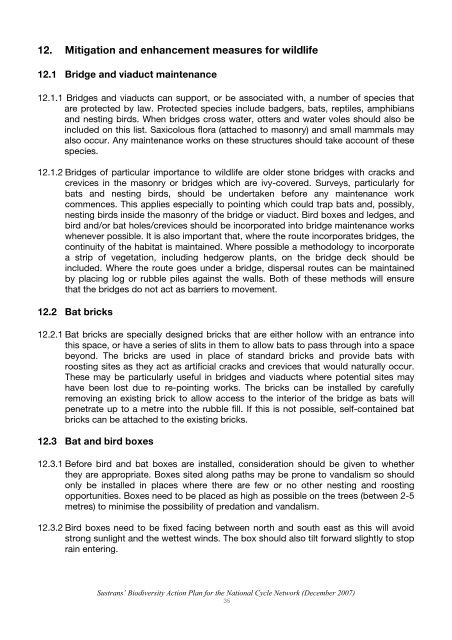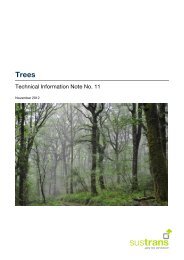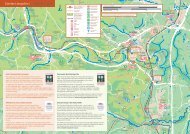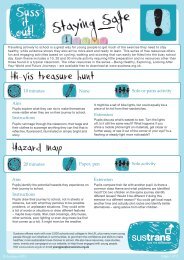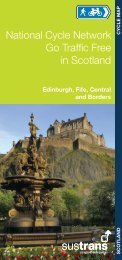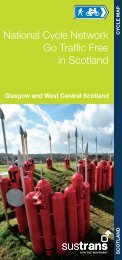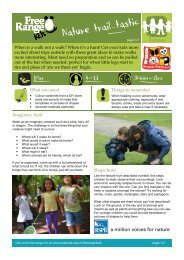Biodiversity Action Plan for the National Cycle Network ... - Sustrans
Biodiversity Action Plan for the National Cycle Network ... - Sustrans
Biodiversity Action Plan for the National Cycle Network ... - Sustrans
You also want an ePaper? Increase the reach of your titles
YUMPU automatically turns print PDFs into web optimized ePapers that Google loves.
12. Mitigation and enhancement measures <strong>for</strong> wildlife<br />
12.1 Bridge and viaduct maintenance<br />
12.1.1 Bridges and viaducts can support, or be associated with, a number of species that<br />
are protected by law. Protected species include badgers, bats, reptiles, amphibians<br />
and nesting birds. When bridges cross water, otters and water voles should also be<br />
included on this list. Saxicolous flora (attached to masonry) and small mammals may<br />
also occur. Any maintenance works on <strong>the</strong>se structures should take account of <strong>the</strong>se<br />
species.<br />
12.1.2 Bridges of particular importance to wildlife are older stone bridges with cracks and<br />
crevices in <strong>the</strong> masonry or bridges which are ivy-covered. Surveys, particularly <strong>for</strong><br />
bats and nesting birds, should be undertaken be<strong>for</strong>e any maintenance work<br />
commences. This applies especially to pointing which could trap bats and, possibly,<br />
nesting birds inside <strong>the</strong> masonry of <strong>the</strong> bridge or viaduct. Bird boxes and ledges, and<br />
bird and/or bat holes/crevices should be incorporated into bridge maintenance works<br />
whenever possible. It is also important that, where <strong>the</strong> route incorporates bridges, <strong>the</strong><br />
continuity of <strong>the</strong> habitat is maintained. Where possible a methodology to incorporate<br />
a strip of vegetation, including hedgerow plants, on <strong>the</strong> bridge deck should be<br />
included. Where <strong>the</strong> route goes under a bridge, dispersal routes can be maintained<br />
by placing log or rubble piles against <strong>the</strong> walls. Both of <strong>the</strong>se methods will ensure<br />
that <strong>the</strong> bridges do not act as barriers to movement.<br />
12.2 Bat bricks<br />
12.2.1 Bat bricks are specially designed bricks that are ei<strong>the</strong>r hollow with an entrance into<br />
this space, or have a series of slits in <strong>the</strong>m to allow bats to pass through into a space<br />
beyond. The bricks are used in place of standard bricks and provide bats with<br />
roosting sites as <strong>the</strong>y act as artificial cracks and crevices that would naturally occur.<br />
These may be particularly useful in bridges and viaducts where potential sites may<br />
have been lost due to re-pointing works. The bricks can be installed by carefully<br />
removing an existing brick to allow access to <strong>the</strong> interior of <strong>the</strong> bridge as bats will<br />
penetrate up to a metre into <strong>the</strong> rubble fill. If this is not possible, self-contained bat<br />
bricks can be attached to <strong>the</strong> existing bricks.<br />
12.3 Bat and bird boxes<br />
12.3.1 Be<strong>for</strong>e bird and bat boxes are installed, consideration should be given to whe<strong>the</strong>r<br />
<strong>the</strong>y are appropriate. Boxes sited along paths may be prone to vandalism so should<br />
only be installed in places where <strong>the</strong>re are few or no o<strong>the</strong>r nesting and roosting<br />
opportunities. Boxes need to be placed as high as possible on <strong>the</strong> trees (between 2-5<br />
metres) to minimise <strong>the</strong> possibility of predation and vandalism.<br />
12.3.2 Bird boxes need to be fixed facing between north and south east as this will avoid<br />
strong sunlight and <strong>the</strong> wettest winds. The box should also tilt <strong>for</strong>ward slightly to stop<br />
rain entering.<br />
<strong>Sustrans</strong>’ <strong>Biodiversity</strong> <strong>Action</strong> <strong>Plan</strong> <strong>for</strong> <strong>the</strong> <strong>National</strong> <strong>Cycle</strong> <strong>Network</strong> (December 2007)<br />
35


